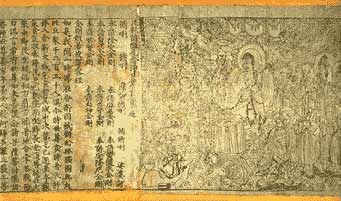

History of Chinese Invention - The Invention of Block Printing |
The invention of printing is generally conceded to be one of the defining inventions for the advancement of civilization. Gutenberg's movable type printing press about 1450 AD is often cited as the single greatest invention for world civilization.Return to History of Chinese Invention and DiscoveryAn important event for the Eastern world that took place during the Tang (618-906) dynasty was the invention of printing, possibly between the 4th and 7th century AD. It began as blocks cut from wood used to print textiles and then used to reproduce short Buddhist religious texts that were carried as charms by believers. Later long scrolls and books were produced, first by wood-block printing and then, beginning in the 11th century, by using movable type. Inexpensive printed books became widely available in China during the Song (960-1279) dynasty.
The first mention of printing was in an imperial decree of 593 in which Sui emperor Wen-ti ordered the printing of Buddhist images and scriptures. The text was first written on a piece of thin paper, then glued face down onto a wooden plate. The characters were carved out to make a wood-block printing plate, which was used to print the text. Wood-block required a new block had to be carved for every page in a book, but when the stamps were complete, an expert could print a thousand or more sheets a day. In the 9th century, printed books first appeared in quantities in Shu (modern Szechuan province) and could be purchased from private dealers. Soon the printing technique spread to other provinces, and by the end of the 9th century it was common all over China. The printed books included Confucian classics, Buddhist scriptures, dictionaries, mathematics and others. The technique was advanced very fast. By 1000, paged books in the modern style had replaced scrolls. Two color printing (black and red) was seen as early as 1340.
The "Diamond Sutra" scroll is the world's earliest, dated, printed book. A central text of Indian Buddhism, the work was first translated from Sanskrit into Chinese in about 400 AD, and block-printed in China in 868 AD.
Although not the earliest example of blockprinting, this scroll is the earliest which bears an actual date. The colophon, at the inner end, reads: "Reverently made for universal free distribution by Wang Jie on behalf of his two parents on the 13th of the 4th moon of the 9th year of Xiantong [i.e., 11th May, 868 AD]". The scroll was found in 1907 by the archaeologist Marc Aurel Stein in a walled-up cave at Dunhuang cave (Caves of the Thousand Buddhas), near the Silk Road in northwest China. It was one of a small number of printed items among many thousands of manuscripts, comprising a library which must have been sealed about 1000 AD. The quality of definition makes it clear that the blockcutter had a considerable experience and skill. It is not known where the printing was carried out, although Sichuan, in southwest China, is known to have been a center of printing activity at this time. These illustrations from the British Library reveal details from the frontispiece (next to the title page), along with a page detail.

As late as the Tang dynasty the production of books by block printing was still practiced on a limited scale. It was not until the time of the Late Tang (923-936) that the government, upon the recommendation of its prime minister Feng Tao, first sponsored the reproduction of the Five Classics by block printing. From then on practically all important books were produced by block printing.
During the Ch'ing-li period (1041-1048) the printing technique was further advanced through the invention of movable type. However, even the greatest technology is constrained by cultural circumstances. Chinese character ideograms are too specific. Consequently, the thousands of distinct characters are difficulte to categorize in molds. And although the more complex characters can often be decomposed into simpler elements, the process of doing so is so unsystematic that mechanising it efficiently proved impossible. True mass printing could only thrive in a culture with a less sophisticated writing system – an alphabet of few characters.
Movable type is a reform in the history of printing and contributed much to human civilization. The basic print technology may have made its way to Europe from China in the 1300s, although some scholars claim that a European had the insight independently. Building on movable type in the 1450s, Dutch goldsmith Johannes Gutenberg transformed Western civilization and society with mass printing, enabling the dispersal of information to the populace. This print invention is regarded by many as the invention of the millennium.
References
Oracle Bones, Stars, and Wheelbarrows
Science and Technology in World History
Ancient Chinese Science and Technology
written by Frank Ross, Jr. and published by Houghton Mifflin Company, Boston, 1982
by James E. McClellan III and Harold Dorn, published by The Johns Hopkins University Press, 1999, p. 125.The Genius of China
3,000 Years of Science, Discovery and Invention
written by Robert K.G. Temple and published by Simon and Schuster, 1986
Currently out-of-printThe Silk Road Foundation Website